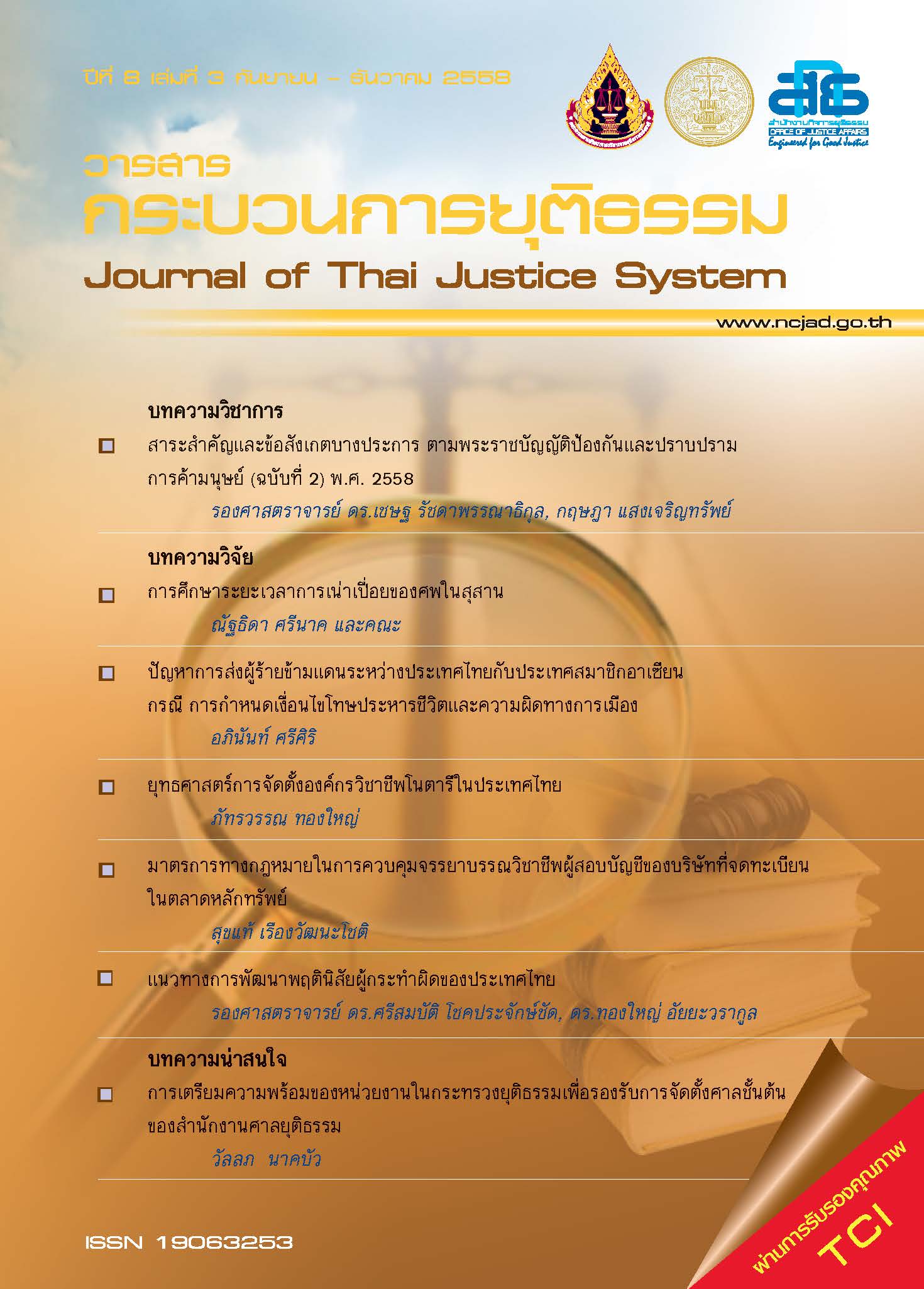Guideline for Throughcare model of Thailand
Main Article Content
Abstract
The objective of this research was to define the concept of offender rahabilitation development, intergrated and comprehensive model for Thailand. By using qualitative reserach, data were collected from documents, in-depth interviews of 29 people with those involved in the academic sector, the private sector and the government sector as well as international conferences with those foreign experts from the U.S., UK, Singapore and Japan. The findings were presented that the Department of Corrections and Department of Probation still face with problems dealing with offender rehadbilitation. This research offers thoughcare model seamlessly five stages, including the classification of criminals, evaluating the program, the pre-release, the reintegration and follow-up and monitoring
Article Details
Published Manuscripts are the copyright of the Journal of the Justice System. However; the opinions that appeared in the content are the sole responsibility of the author.
References
กรมคุมประพฤติ. (2558). เอกสารเผยแพร่กองพัฒนาการฟื้นฟูฯ. (มปท).
นัทธี จิตสว่าง. (มปป.). ลำดับขั้นของการพัฒนางานราชทัณฑ์. คัดลอกเมื่อ 1 เมษายน 2558 จาก http://www.gotoknow.org/posts/486961
ประมวลกฎหมายอาญา, มาตรา 56
ประกาศคณะรักษาความสงบแห่งชาติ ฉบับที่ 108/2557 (2557). ราชกิจจานุเบกษา. เล่ม 131 ตอนพิเศษ 143 ง หน้า 18 ลงวันที่ 30 กรกฎาคม 2557.
ปรีชญาณ์ นักฟ้อน และเกษมศาสต์โชติชาครพันธ์. การดำนเนิงานการพัฒนาพฤตินิสัยผู้ต้องขังในงานราชทัณย์ไทย" ใน โครงการจัดทำรายงานการรับฟังความคิดเห็นการปฏิรูประบบการดำเนินการ. สำนักงานกิจการยุติธรรม กระทรวงยุติธรรม
เพชรรัตน์ อิงคสารมณี. (2008). ปัญหาในการปฏิบัติงานตามโปรแกรมแก้ไขฟื้นฟูผู้ต้องขังขอกรมราชทัณฑ์. วิทยานิพนธ์ศิลปศาสตร์มหาบัณฑิต (การบริหารงานยุติธรรม). คณะสังคมสงเคราะห์ศาสตร์ มหาวิทยาลัย ธรรมศาสตร์
พระราชบัญญัติฟื้นฟูสมรรถภาพผู้ติดยาเสพติด พ.ศ. 2545. ราชกิจจานุเบกษา. เล่มที่ 119 ตอนที่ 96 ก หน้า 26 ลงวันที่ 30 กันยายน 2545.
ศักดิ์ชัย เลิศพานิชพันธุ์ (2558). รายงานฉบับ สมบูรณ์: การศึกษาการสร้างทางเลือกที่เหมาะสมด้วยมาตรการไม่คุมขังกับผู้ต้องขังหญิงและการหลักเลี่ยงการใช้โทษจำคุก และการสร้างความฉลาดรู้ทางกฎหมายตามข้อกำหนดกรุงเทพฯ (Bangkok Rules). กรุงเทพมหานคร: โรงพิมพ์ Jprint.
สำนักงานปลัดกระทรวงยุติธรรม (2558).(ร่าง) แผนยุทธศาสตร์กระทรวงยุติธรรม พ.ศ. 2558-2561 (ฉบับปรับปรุง 3 กุมภาพันธ์ 2558) สำนักนโยบบายและยุทธศาสตร์. สำนักงานปลัดกระทรวงยุติธรรม กระทรวงยุติธรรม
ภาษาอังกฤษ
Aos, S., Phipps, P., Barnnoski, R., and Lieb, R. (2001). The comparative costs and benefits of programs to reduce crime, vol.4 (1-05-1201). Olympia, WA:Washington State Institute for Public Policy.
Becker, G. (1968). Crime and Punishment: An Economic Approach. Journal of Political Economy, 76(20), 169-217.
Chartered Institute of Personnel and Development. (CIPD) (2007), Employing ex-offenders to capture talent, Survey Report May 2007.
Cohen, M.A. (2000). Measuring the costs and benefits of crime and justice, in LaFree G, Measurement and nalysis of crime and justice. Washington, DC:National Institute of Justice US Department of Justice.
DhiriS & Brand, S. (1999). Analysis of costs and benefits: Guidance to evaluators. Crime reduction programme guidance note 1. London: Home Office.
Dossetor, K. (2011). Cost-benefit analysis and its application to crime prevention and criminal justice research. Canberra, Australia: Australian Institute of Criminology.
Fagin, J. A.(2010). Upper Saddle River. NJ: Prentice Hall.
Farrel, G. Bowers, K. and Johnson, S.D. (2005). Cost-benefit analysis for crime science: Making cost-benefit analysis useful through a portfolio of outcomes, in Smith, M. and Tilley, N. (eds), Crime science: New approaches to preventing and detecting crime. London: Willan Press.
Kripendoff, K. (2004). Content Analysis: An Introduction to Its Methodology (2nd ed.). Thousand Oaks, CA: Sage.
McDougall, C., Cohen, M. A., Swaray, R., & Perry, A. (2003). The costs and benefits of sentencing: a systematic review. The Annals of the American Academy of Political and Social Science, 587(1), 160-177.
Sarmiento, L. (2011). Governement incentives for hiring returning prisoners. Northwestern Law. Bluhm Legal Clinic.
Weimer, D.L., & Friendman, L.S. (1979). Efficiency considerations in criminal rehabilitation research: Costs and consequences. in L. Sechrest, S.O.White, & E.D. Brown (Eds.), The rehabilitation of criminal offenders: Problems and prospects (pp.251-272). Washington, DC: national Academy of Sciences.


